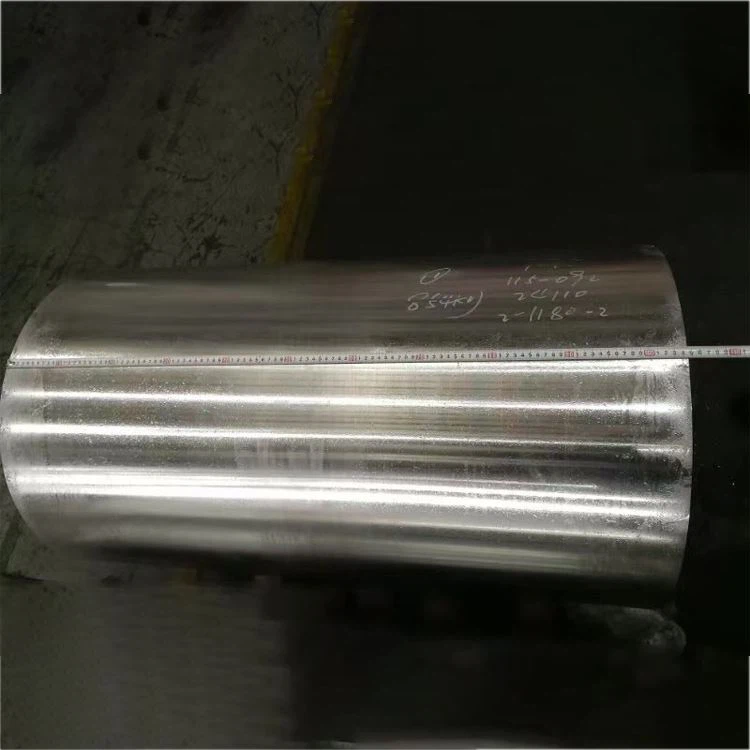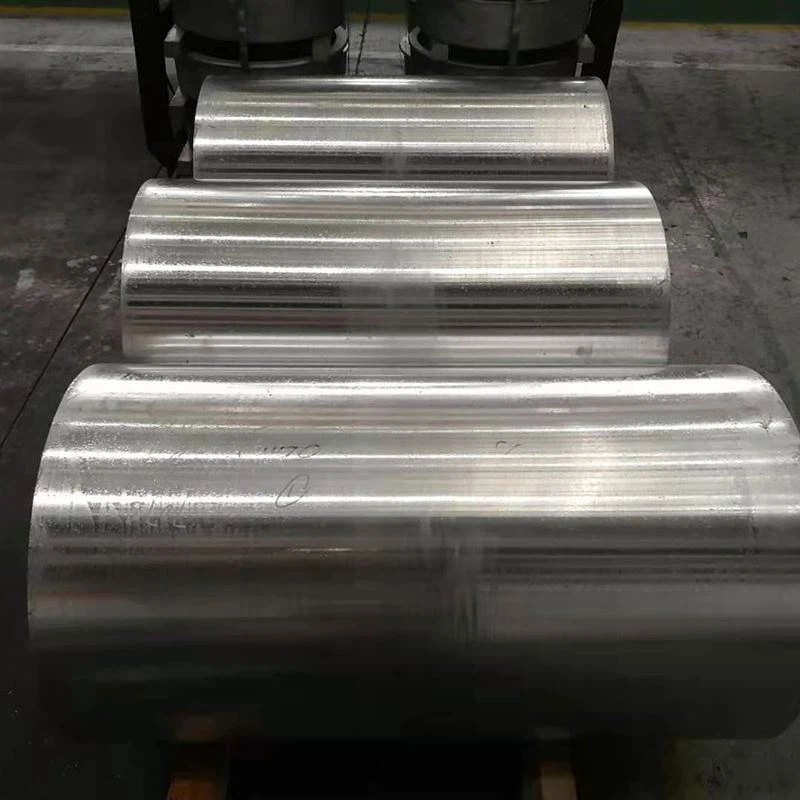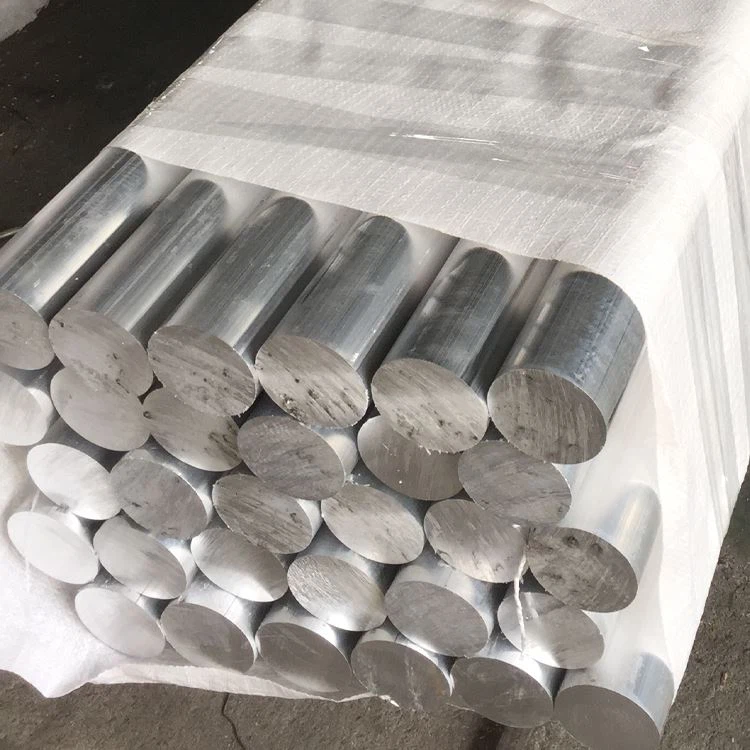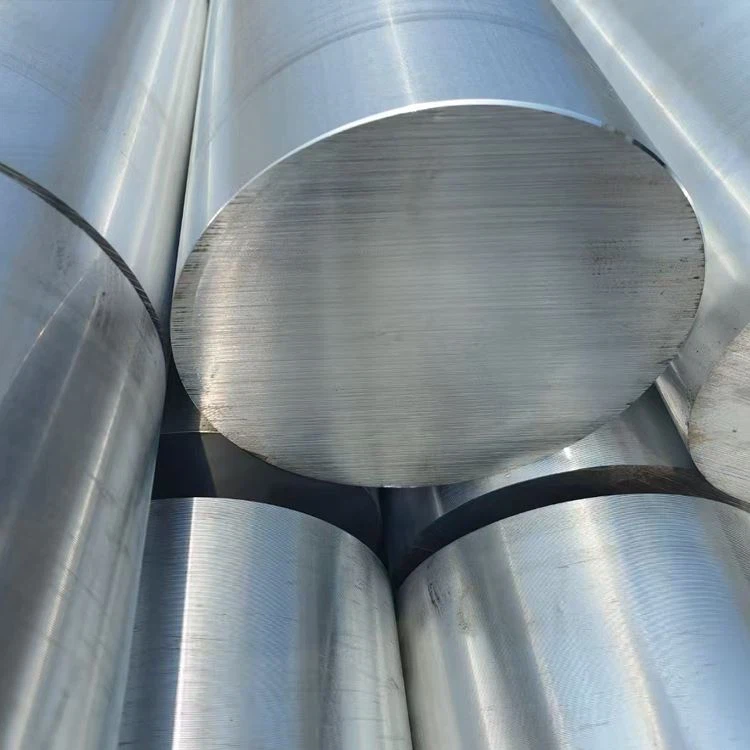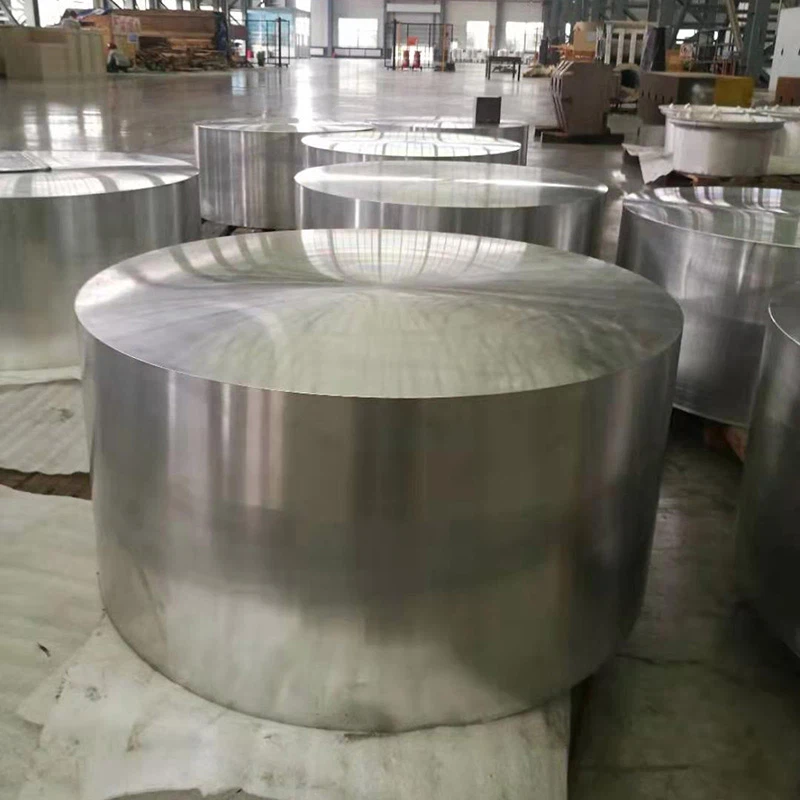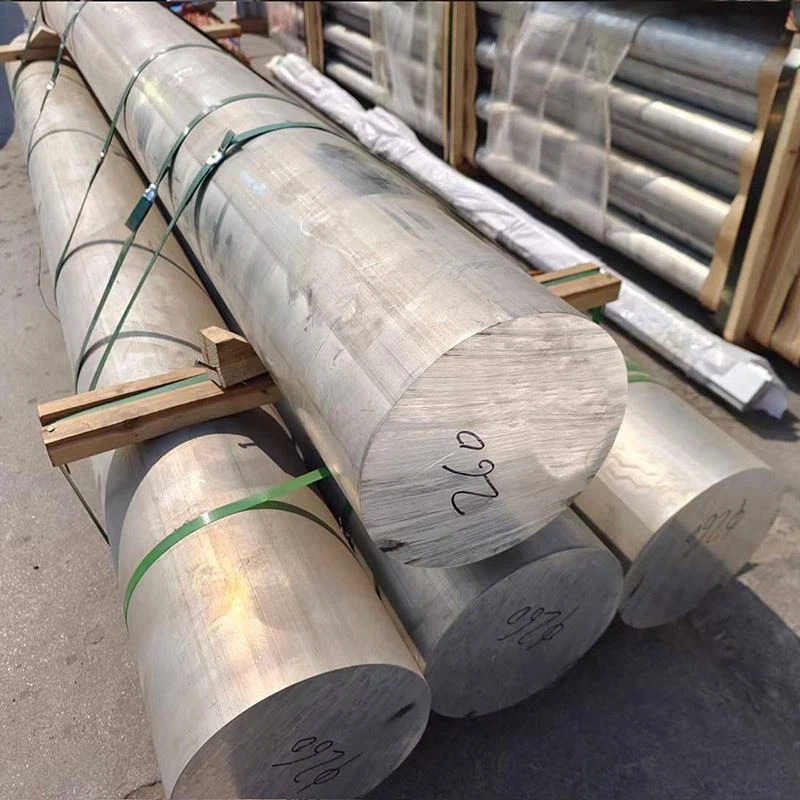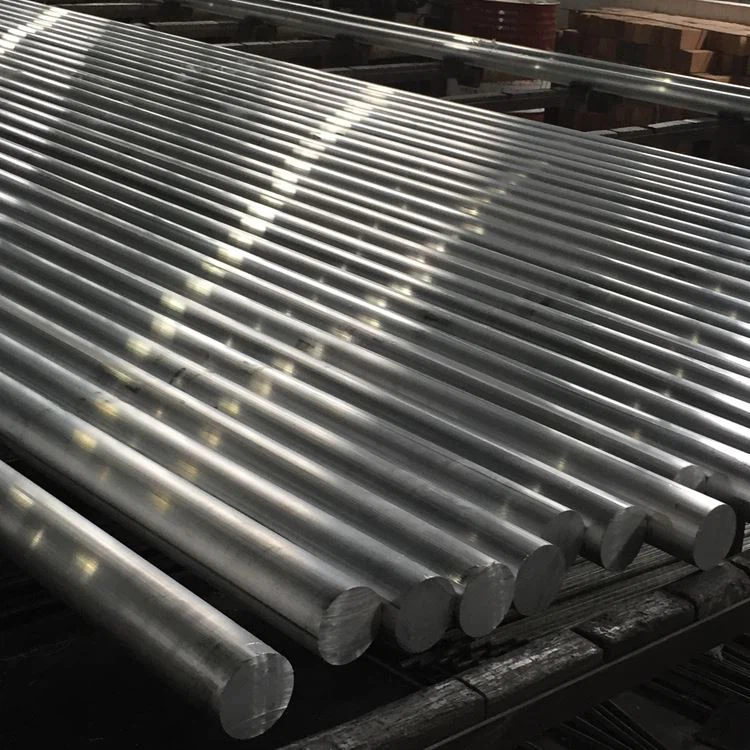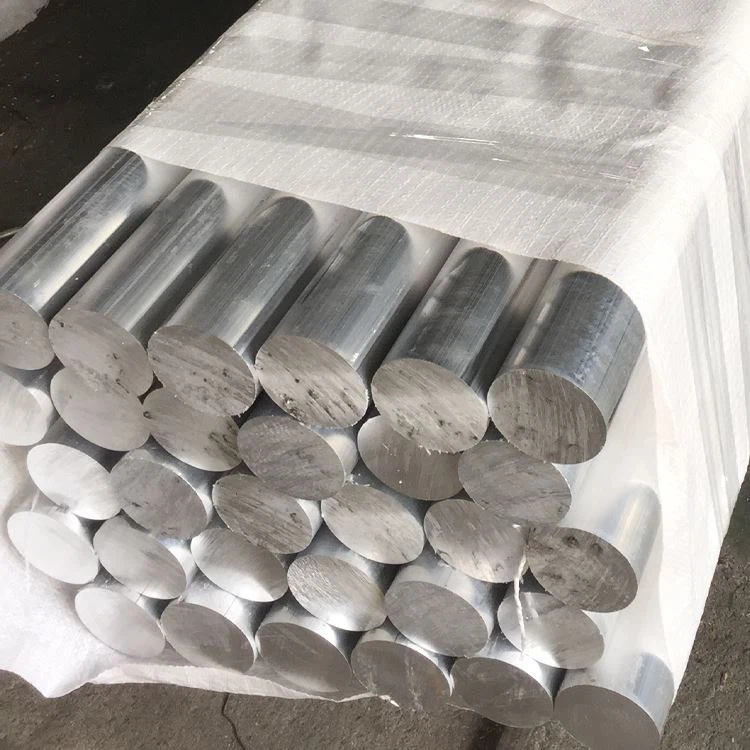1. Material Composition & Manufacturing Process
6061 large diameter aluminum alloy bar is a versatile, heat-treatable aluminum-magnesium-silicon alloy that offers excellent strength, good corrosion resistance, superior weldability, and machinability across a wide range of diameters, making it ideal for structural, mechanical parts, transportation, and general engineering applications:
Primary Alloying Elements:
Magnesium (Mg): 0.8-1.2% (enhances strength)
Silicon (Si): 0.4-0.8% (forms Mg₂Si strengthening phase with Magnesium)
Copper (Cu): 0.15-0.40% (improves strength, slightly reduces corrosion resistance)
Chromium (Cr): 0.04-0.35% (inhibits recrystallization, improves stress corrosion resistance)
Base Material:
Aluminum (Al): ≥95.8% (balance)
Controlled Impurities:
Iron (Fe): ≤0.70% max
Zinc (Zn): ≤0.25% max
Manganese (Mn): ≤0.15% max
Titanium (Ti): ≤0.15% max
Other elements: ≤0.05% each, ≤0.15% total
Premium Manufacturing Process:
Melt Preparation:
High-purity primary aluminum (99.7% minimum)
Precise alloying element additions with ±0.05% tolerance
Advanced filtration through ceramic foam filters (30-40 ppi)
SNIF degassing treatment (hydrogen < 0.10 ml/100g)
Grain refinement with Al-Ti-B master alloy
Direct-chill (DC) semi-continuous casting to produce large diameter ingots
Homogenization:
550-580°C for 6-12 hours
Uniform temperature control: ±5°C
Controlled cooling rate: 15-25°C/hour
Dissolution of coarse intermetallics, elimination of microsegregation
Hot Working (Extrusion or Forging):
Large extrusion presses: Capable of producing bars up to 400mm diameter
Or Forging: Processing ingots into bars via radial forging or closed-die forging
Deformation temperature: 450-500°C
Ensures adequate deformation and grain refinement for optimal internal quality and grain flow
Solution Heat Treatment:
520-550°C for 1-4 hours (diameter dependent)
Temperature uniformity: ±3°C
Rapid transfer to quenching medium (<10 seconds)
Quenching:
Water quench or polymer quench
Controlled cooling rate for optimal hardness
Stress Relief (for T651/T6511 Tempers):
Controlled stretching (1-3% plastic deformation) to reduce residual stress
Artificial Aging (T6 Temper):
160-180°C for 8-18 hours
Temperature uniformity: ±3°C
All production stages are subject to rigorous quality control and traceability management.
2. Mechanical Properties of 6061 Large Diameter Aluminum Bar
| Property | O (Annealed) | T4 | T6 | T651/T6511 | Test Method |
| Ultimate Tensile Strength | 110-145 MPa | 180-220 MPa | 290-320 MPa | 290-320 MPa | ASTM E8 |
| Yield Strength (0.2%) | 40-60 MPa | 90-120 MPa | 240-270 MPa | 240-270 MPa | ASTM E8 |
| Elongation (2 inch) | 16-25% | 14-20% | 8-15% | 8-15% | ASTM E8 |
| Hardness (Brinell) | 30-40 HB | 60-75 HB | 95-105 HB | 95-105 HB | ASTM E10 |
| Fatigue Strength (5×10⁸ Cycles) | 70-90 MPa | 90-110 MPa | 95-110 MPa | 95-110 MPa | ASTM E466 |
| Shear Strength | 70-90 MPa | 110-130 MPa | 190-210 MPa | 190-210 MPa | ASTM B769 |
| Modulus of Elasticity | 68.9 GPa | 68.9 GPa | 68.9 GPa | 68.9 GPa | ASTM E111 |
Property Distribution:
Axial vs. Radial properties: <5% variation in strength properties
Internal property variation across large diameter bars: typically less than 7% for T6/T651 tempers
Core to surface hardness variation: <5 HB
Residual stress: Low stress levels in T651/T6511 tempers, reducing machining distortion
3. Microstructural Characteristics
Key Microstructural Features:
Grain Structure:
Elongated grains with some recrystallized grains after hot working
ASTM grain size 4-7 (90-32μm)
Ensures uniform grain structure and refinement within large diameter bars through strict process control
Precipitate Distribution:
Mg₂Si strengthening phase: Fine and uniformly dispersed, providing primary strengthening
AlFeSi intermetallics: Controlled size and distribution
Cr₂Si or Al₁₂Mg₂Cr dispersoids: Inhibits grain growth, improves stress corrosion resistance
Texture Development:
Fiber texture introduced by extrusion/forging
Texture strength has minor impact on mechanical properties; grain refinement and precipitation hardening are dominant
Special Features:
Uniform distribution of precipitates at grain boundaries
Supersaturated solid solution after solution treatment
Formation of precipitation phases after aging treatment
4. Dimensional Specifications & Tolerances
| Parameter | Standard Range | Precision Tolerance | Commercial Tolerance | Test Method |
| Diameter | 100-600 mm | ±0.5mm up to 200mm | ±1.0mm up to 200mm | Micrometer/Caliper |
| ±0.25% above 200mm | ±0.5% above 200mm | |||
| Ovality | N/A | 50% of diameter tolerance | 75% of diameter tolerance | Micrometer/Caliper |
| Length | 1000-7000 mm | ±5mm | ±10mm | Tape measure |
| Straightness | N/A | 0.8mm/m | 1.5mm/m | Straightedge/Laser |
| Surface Roughness | N/A | 3.2 μm Ra max | 6.3 μm Ra max | Profilometer |
| Cut End Squareness | N/A | 0.5° max | 1.0° max | Protractor |
Standard Available Forms:
Large Diameter Round Bar: Diameters 100mm to 600mm
Custom cut-to-length service available
Special tolerances and surface finishes (e.g., peeled, ground, precision turned) available upon request
Available in as-quenched and aged, or quenched-stretched-aged (T651) tempers
5. Temper Designations & Heat Treatment Options
| Temper Code | Process Description | Optimal Applications | Key Characteristics |
| O | Fully annealed, softened | Applications requiring maximum formability | Lowest strength, maximum ductility |
| T4 | Solution heat treated and naturally aged | Good formability with moderate strength requirements | Moderate strength, good formability |
| T6 | Solution heat treated and artificially aged | High-strength, structural applications | Maximum strength and hardness |
| T651 | T6 + stress relieved by stretching | Critical structural components, low residual stress | Excellent dimensional stability, low machining distortion |
| T6511 | T6 + slight stretch + straightening | Low residual stress for irregular shapes | Similar to T651, but for irregular cross-sections |
Temper Selection Guidance:
O: For complex cold forming operations
T4: For applications requiring subsequent forming or welding, with final heat treatment
T6: For general structural and mechanical parts requiring high strength
T651/T6511: For large diameter bars requiring minimal machining distortion and high dimensional stability
6. Machining & Fabrication Characteristics
| Operation | Tool Material | Recommended Parameters | Comments |
| Turning | Carbide, Diamond | Vc=250-600 m/min, f=0.1-0.5 mm/rev | High-speed machining yields excellent surface finish |
| Drilling | Carbide, TiN coated | Vc=80-200 m/min, f=0.15-0.40 mm/rev | Through-coolant drills recommended, good for deep holes |
| Milling | Carbide, HSS | Vc=200-800 m/min, fz=0.1-0.25 mm | High-positive rake angle tools, large depth of cut, high feed |
| Tapping | HSS-E-PM, TiCN coated | Vc=20-40 m/min | Good thread quality, easy to tap |
| Reaming | Carbide, HSS | Vc=80-150 m/min, f=0.2-0.6 mm/rev | H7/H8 tolerance achievable |
| Sawing | Carbide-tipped blade | Vc=1000-3000 m/min | Efficient cutting, smooth cut edges |
Fabrication Guidance:
Machinability Rating: 80% (1100 aluminum = 100%), improved machinability in T6 temper
Chip Formation: Easily forms short, curled chips, facilitating chip evacuation
Coolant: Water-soluble cutting fluid (5-10% concentration)
Tool Wear: Low, leading to long tool life
Weldability: Excellent with TIG and MIG welding, minimal strength loss after welding
Heat Treatment: Can be quenched and aged to enhance strength
Anodizing: Easily anodized for aesthetic and corrosion-resistant surfaces
Brazing and Soldering: Possible
Residual Stress: T651/T6511 tempers significantly reduce residual stress, minimizing machining distortion
7. Corrosion Resistance & Protection Systems
| Environment Type | Resistance Rating | Protection Method | Expected Performance |
| Industrial Atmosphere | Very Good | Clean surface, optional anodizing | 15-20+ years |
| Marine Atmosphere | Good | Anodizing + sealing or painting | 5-10+ years with maintenance |
| Seawater Immersion | Fair | Cathodic protection or painting | Dependent on coating quality |
| High Humidity | Very Good | Clean surface, optional anodizing | 10-15+ years |
| Stress Corrosion | Very Good | Excellent performance in T6 temper | Low susceptibility |
| Exfoliation | Very Good | Standard protection | Good resistance |
| Galvanic Corrosion | Good | Proper isolation | Careful design with dissimilar metals |
Surface Protection Options:
Anodizing:
Type II (Sulfuric): 10-25μm thickness, for decorative and general protection
Type III (Hard): 25-75μm thickness, for wear resistance and higher protection
Dyeing and sealing: Enhances aesthetics and corrosion resistance
Conversion Coatings:
Chromate conversion coatings (MIL-DTL-5541): Excellent adhesion and corrosion protection
Chromium-free alternatives: Environmentally compliant
Painting Systems:
Epoxy primer + polyurethane topcoat: For harsh environments
Powder coating: High durability and aesthetics
Others:
Electroplating, vacuum coating, etc.
8. Physical Properties for Engineering Design
| Property | Value | Design Consideration |
| Density | 2.70 g/cm³ | Weight calculation and structural optimization |
| Melting Range | 582-652°C | Heat treatment and welding window |
| Thermal Conductivity | 167 W/m·K | Heat dissipation and transfer design |
| Electrical Conductivity | 40-43% IACS | Electrical conductivity in electrical applications |
| Specific Heat | 897 J/kg·K | Thermal mass and heat capacity calculations |
| Thermal Expansion (CTE) | 23.6 ×10⁻⁶/K | Dimensional changes due to temperature variations |
| Young’s Modulus | 68.9 GPa | Deflection and stiffness calculations |
| Poisson’s Ratio | 0.33 | Structural analysis parameter |
| Damping Capacity | Medium-Low | Vibration and noise control |
Design Considerations:
Operating Temperature Range: -80°C to +150°C
High-Temperature Performance: Strength begins to decrease above 100°C
Cryogenic Performance: Slight increase in strength at low temperatures, no brittle transition
Magnetic Properties: Non-magnetic
Recyclability: 100% recyclable with high scrap value
Formability: Good in T4 temper, limited in T6 temper
Dimensional Stability: Excellent in T651/T6511 tempers, suitable for precision machining
Strength-to-Weight Ratio: Advantageous in structural applications
9. Quality Assurance & Testing
Standard Testing Procedures:
Chemical Composition:
Optical emission spectroscopy
X-ray fluorescence analysis
Verification of all major elements and impurity content
Mechanical Testing:
Tensile testing (longitudinal and transverse)
Hardness testing (Brinell, multiple locations)
Fatigue testing (as required)
Nondestructive Testing:
Ultrasonic inspection (100% volumetric, per ASTM B594/E2375)
Eddy current testing (surface and near-surface defects)
Penetrant inspection (surface defects)
Microstructural Analysis:
Grain size determination
Precipitate and intermetallic evaluation
Grain flow pattern verification (for forged bars)
Dimensional Inspection:
CMM (Coordinate Measuring Machine) verification
Diameter, length, straightness, ovality, etc.
Standard Certifications:
Material Test Report (EN 10204 3.1 or 3.2)
Chemical analysis certification
Mechanical properties certification
Heat treatment certification
Nondestructive testing certification
Conformance to ASTM B221 (for extruded bar), ASTM B211 (for rolled/cold-finished bar), or ASTM B247 (for forged bar) as applicable
10. Applications & Design Considerations
Primary Applications:
Structural Components:
Architectural frames and supports
Bridge components
Truck and marine structures
Automation machinery bases
Mechanical Parts:
Valve bodies, pump bodies
Drive shafts, gears
Bolts, nuts, fasteners
Jigs and fixtures
Transportation Industry:
Automotive parts (chassis, suspension)
Railway car components
Bicycle frames
Yacht and boat components
Electronics and Precision Equipment:
Semiconductor equipment parts
Electronic component housings
Medical device components
Optical equipment brackets
Recreation and Consumer Goods:
Fishing reels
Sporting goods
Photographic equipment
Design Advantages:
Good overall performance: high strength, corrosion resistance, easy to machine, weldable
Good strength-to-weight ratio in T6 temper
Significant strength improvement after quenching and aging
Low machining distortion in T651/T6511 tempers
Easy to anodize and apply various surface treatments
Excellent welding characteristics
Highly versatile for various industries
Non-magnetic for specific applications
Good recyclability
Design Limitations:
Lower strength compared to 7xxx series alloys
Corrosion resistance in some marine environments is not as good as 5xxx series alloys
Not suitable for applications requiring ultra-high hardness and wear resistance
Limited high-temperature strength performance (above 150°C)
Cold forming ability is not as good as alloys like 5052
Strength in the welded area may slightly decrease
Economic Considerations:
Excellent performance at a reasonable cost, making it ideal for many applications
Wide supply chain and production capacity
Relatively low machining costs
Good recyclability reduces scrap costs
Sustainability Aspects:
100% recyclable, high resource utilization
Lower energy consumption in production compared to steel
Relatively low environmental impact throughout its lifecycle
Long service life reduces replacement frequency
Complies with RoHS and REACH standards, free of harmful substances
Material Selection Guidance:
Choose 6061 when a general-purpose alloy with high strength, good weldability, and corrosion resistance is needed
Choose 5052 when maximum formability is required and strength is less critical
Consider 2xxx or 7xxx series alloys when higher strength is paramount and weldability is not a primary concern
T6 temper is suitable for most structural and mechanical parts
T651/T6511 tempers are suitable for parts requiring precision machining and low residual stress

